In Praise Of Clocks As Both A Precision Instrument And A Roommate: Highlighting Naeschke Clocks From Germany
The Grand Prix d’Horlogerie de Genève (GPHG) has had a dedicated category for mechanical clocks since 2022. The GPHG rules state that the category is for, “Mechanical Clocks [are] mechanical time-measuring instruments, such as longcase clocks or table clocks. Wristwatches are not allowed in this category.”
Clocks: Impressive, Precise, Reassuring
Clocks have many attributes. They usually have slow-beating movements and can be/should be highly accurate. For centuries, clocks provided the most accurate determination of time, which was essential for science, navigation, business, and life in general. Clocks come in all shapes and sizes: table clocks, wall clocks, desk clocks, pendulum clocks, longcase/grandfather clocks, and marine chronometers.
And there is one important aspect of clocks that’s worth highlighting: they are, above all, the basis for everything that came much later i.e., first pocket watches and then wristwatches. Modern clocks are the link between the large public tower clocks and our now ubiquitous wristwatches. Clocks were first instruments before some became luxury status symbols. Clocks had to indicate the time as accurately and as reliably as humanly possible.
The most accurate clocks were considered the best clocks.
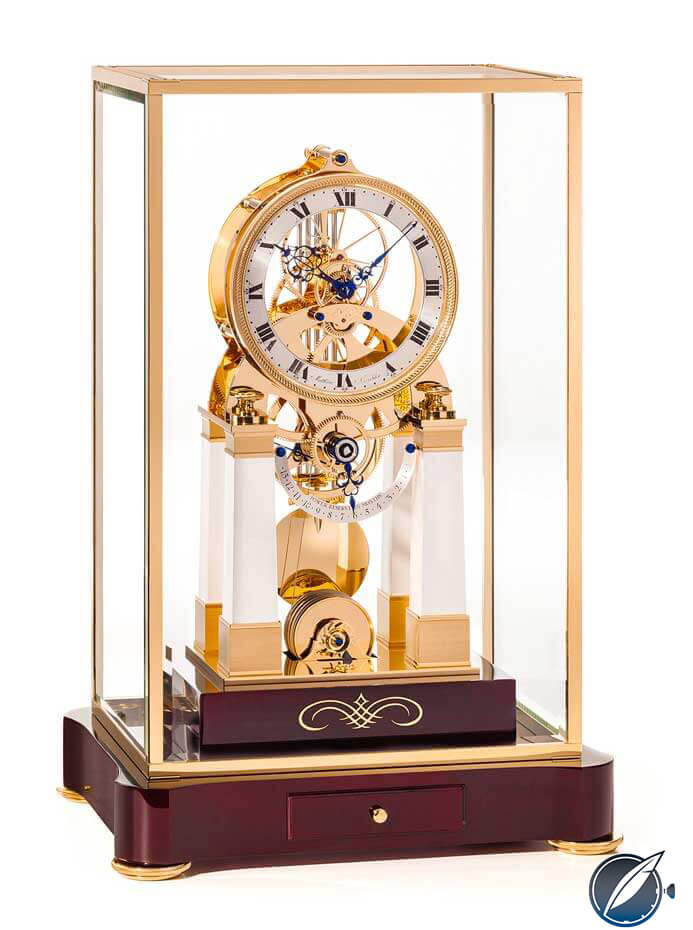
Naeschke NT 12 table clock with 12-month power reserve
Clocks can store lots of power
The Naeschke NT12 table clock, has an enormous power reserve of 12 months, you only need to wind it once a year! The tremendous power of this movement is transmitted via a strong steel cable because conventional gearing could not transmit the spring force, it would likely blow apart. The power reserve indicator displays the stored energy in months (not hours) on a separate dial below the time indication. It is a precise, powerful, and reliable time machine.
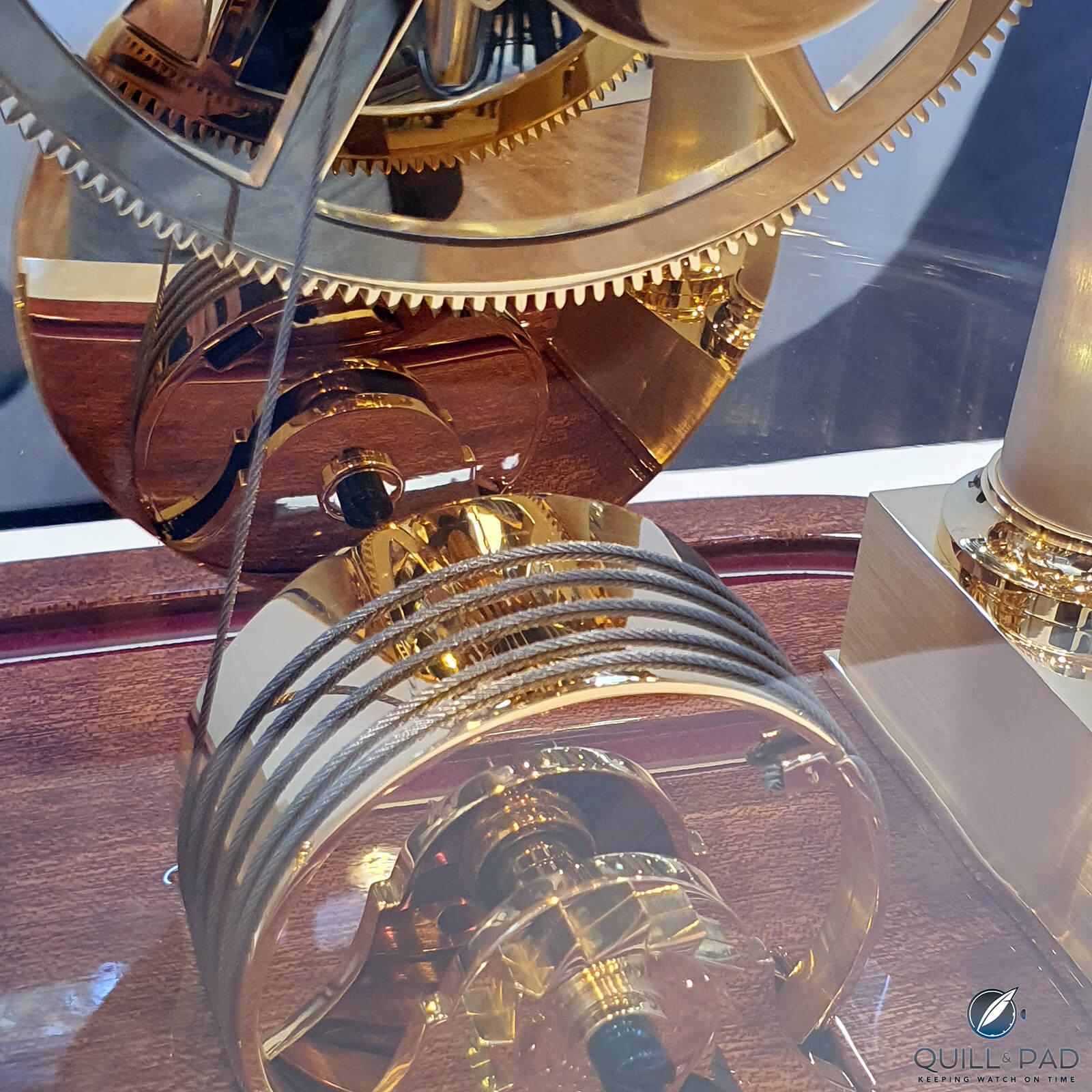
Naeschke NT 12 power transmission cable
Naeschke NT 12: price €74,850, more information at https://fine-clocks.com/clocks/clocks/table-clocks/table-clock-nt-12
Clocks As Instruments For Precise Timekeeping
Today, most of the horological talk is about wristwatches – often wristwatches from famous or well-known brands – but also wristwatches from the independent watchmakers. But where is the passion for the precise reference clock? I encourage everyone, not just watch collectors, to own at least one large clock as both a roommate and an instrument to set your wristwatch in style.
I can remember my parents’ home in which a very large and gently ticking regulator clock reliably displayed the time. Thanks to historic clockmakers makers and inventors like Thomas Mudge, George Graham, and John Harrison, clocks tick reassuringly beautifully and, amazingly, run much more accurately over very long periods of time than many wristwatch chronometers.
Clocks highlight how fundamental precision in timekeeping was (and is) in our lives.
Where are all the clocks? Who makes them for us? What do they look like, what indications do they have, what other complications do they bring along?
There are many well-known precision and complicated clocks in museums and collections. However, when you start thinking about modern clocks, the first name that comes to mind for many is the Atmos by Jaeger LeCoultre, or possibly the precision regulators from Erwin Sattler, l’Epeé, or an artistic Utinam (Silberstein and Lebru).
And there are the clocks from the German precision clockmaker, Naeschke.
Naeschke – Clocks made in Germany
Naeschke Finest Classic Clockmaking is located in a small city named Haigerloch, halfway between Stuttgart (Germany) and Schaffhausen (Switzerland) in the Swabian mountains.
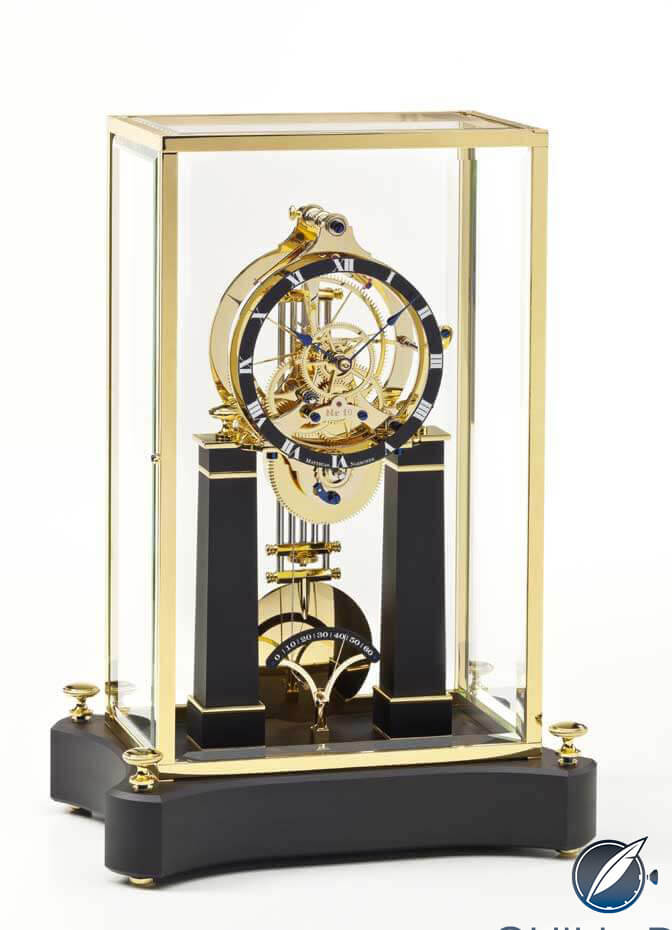
Naeschke NT 6 table clock with retrograde small seconds mechanism
The Naeschke NT 6 table clock is fascinating because of its retrograde small seconds mechanism. This table clock has a power reserve of 14 days and it is based on the table clock “La Gracieuse” caliber 6. The NT 6 is optionally available with a retrograde jumping seconds indication – every minute, the seconds hand describes an angle of 90 degrees before making an instantaneous return jump to 0.
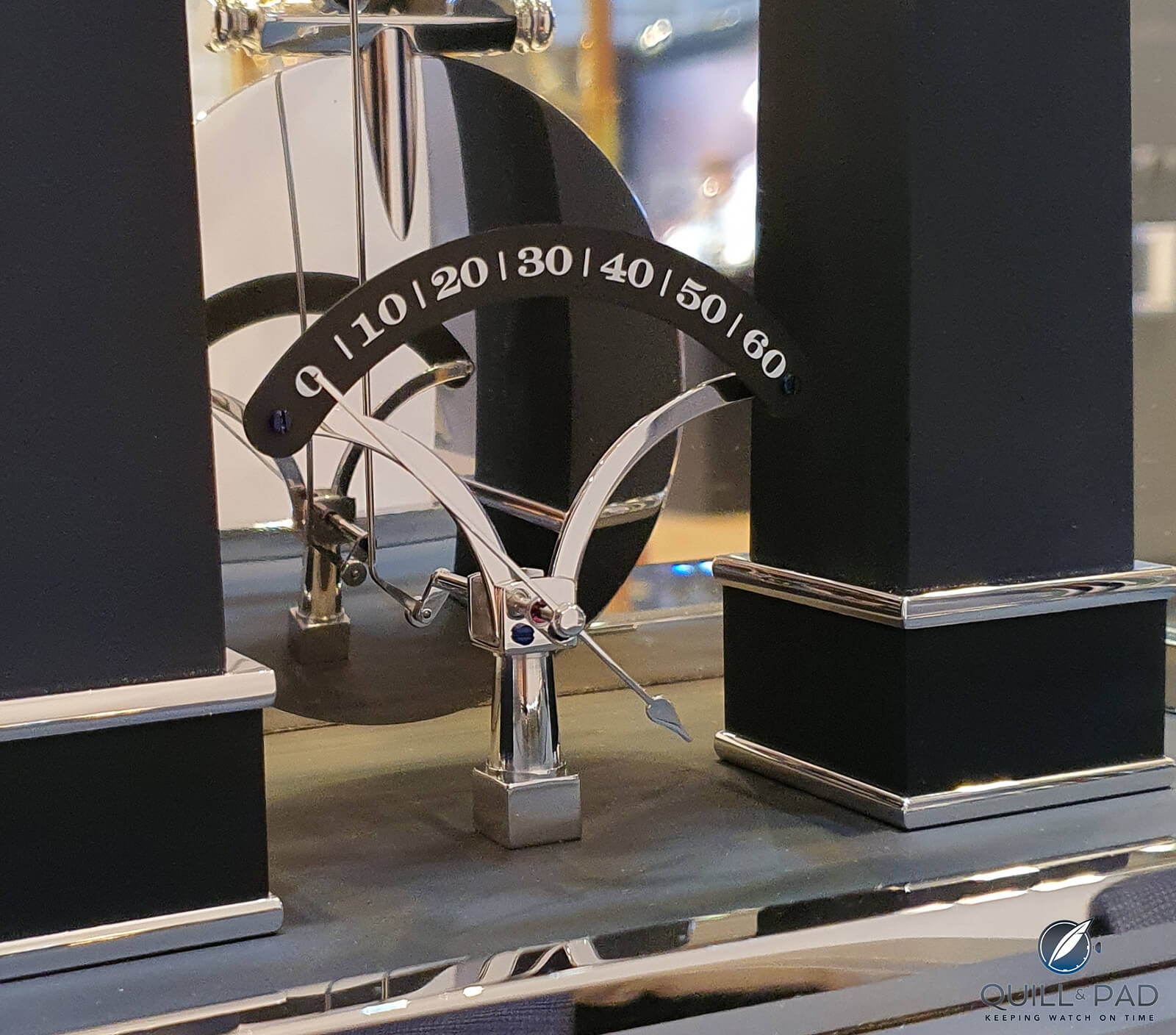
Naeschke NT 6 retrograde seconds (photo courtesy Thomas Brechtel)
Naeschke NT 6 with retrograde seconds: price €26.950, more information at https://fine-clocks.com/clocks/clocks/table-clocks/table-clock-nt-6-la-gracieuse
Matthias Naeschke – “Feinste Uhrmacherei – Finest Classic Clockmaking made in Germany” makes longcase clocks, wall clocks, table clocks and music clocks. He is not only a clockmaker, but also a musician (like many other well-known horologists including Dan Spitz, Ivo Staudt, Anthony de Haas, Miki Eleta, Sebastian Naeschke, to name just a few). Matthias Naeschke worked for many years for well-known manufacturers in Switzerland and England before producing his own clocks (including the rare music- or organ clocks) in 1984. Musical clocks are still available from Naeschke today.

Naeschke organ clock with 26 pipes
The organ clock is a mechanical clock that is also a music machine. Naeschke makes a heavy organ clock with 26 wooden pipes that plays music (they also offer a simpler model with 17 pipes). The inner part consists of a clockwork and a barrel. The movement has a power reserve of 14 days provided by two barrels working with a constant force escapement and an escapement beating at 2 Hz (14.400 bph). This clock chimes the hours, and the musical part of the movement can also be muted (the organ plays 30 seconds).
Up to six musical tunes can be stored (or better pinned) on the music barrel. The face has a white enamel dial with gilded hands and the case is made of cherry wood. Several glass panels allow the owner to see the movement. This organ clock is a masterpiece combining several traditional handcrafts that can usually only be seen in museums.
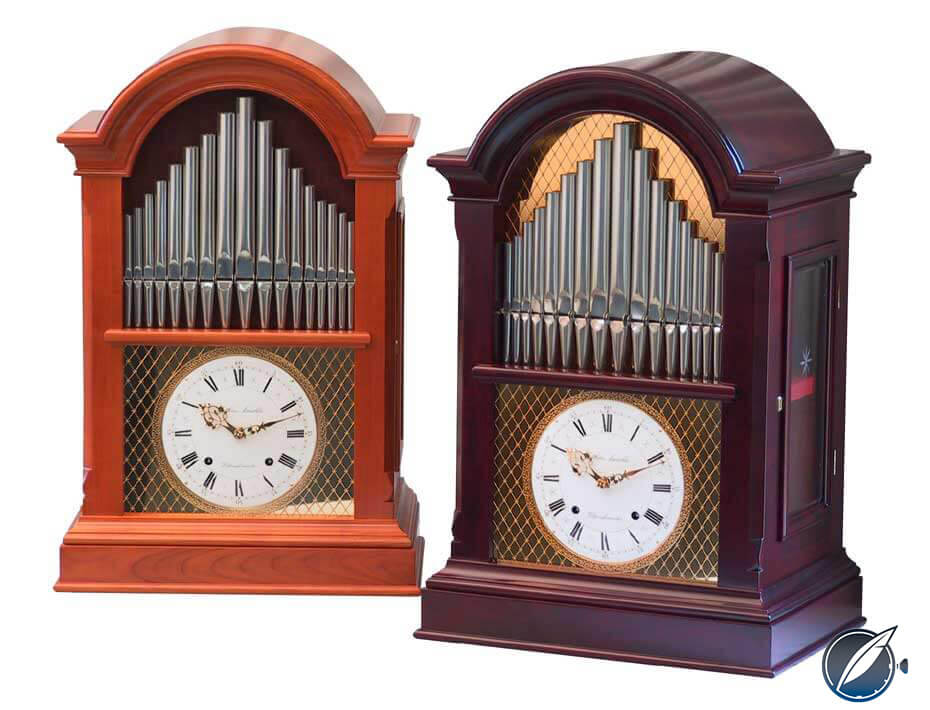
Naeschke organ clock with 17 pipe
Naeschke organ clocks: price starting around €45,000, more information at https://fine-clocks.com/clocks/organ-clocks/table-organ-clocks/table-organ-clocks-26-pipes and https://fine-clocks.com/clocks/organ-clocks/table-organ-clocks/table-organ-clocks-17-pipes
Matthias and Sebastian Naeschke
Matthias Naeschke has been a member of the AHCI since 1986. His son, Sebastian Naeschke, embodies the company’s second generation of watchmakers. And like his father, he is also a musician. As a watchmaker, he has worked for IWC in Schaffhausen and for Helmut Sinn in Frankfurt (Sinn, Guinand, Chronosport and Jubilar). Sebastian Naeschke has been a member of the AHCI since 2006. Naeschke’s clocks are among the world’s finest clocks – for me they are beautiful and unique. Naeschke manufactures regulators, longcase clocks, table clocks, and musical clocks.
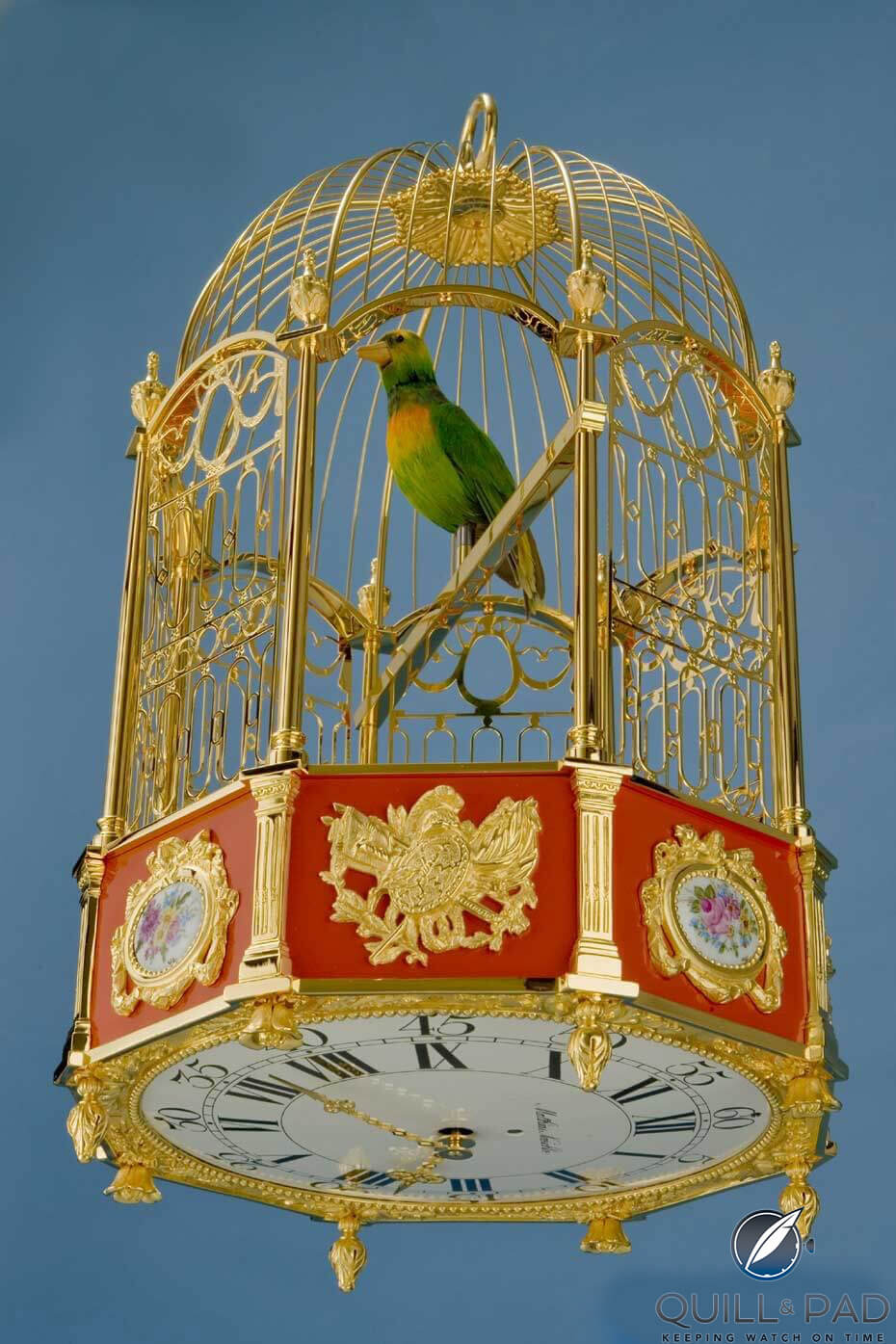
Naeschke Singing Bird automaton clock
Naeschke clocks are classic, large, heavy, precise, feature superb craftsmanship, and are impressively beautiful. There are five collections of clocks at Naeschke: the table clocks (denoted with NT), the regulators (denoted with NR), the longcase clocks (denoted with NL), the table organ/music clock with either 17 or 26 pipes, and a birdcage music automaton.
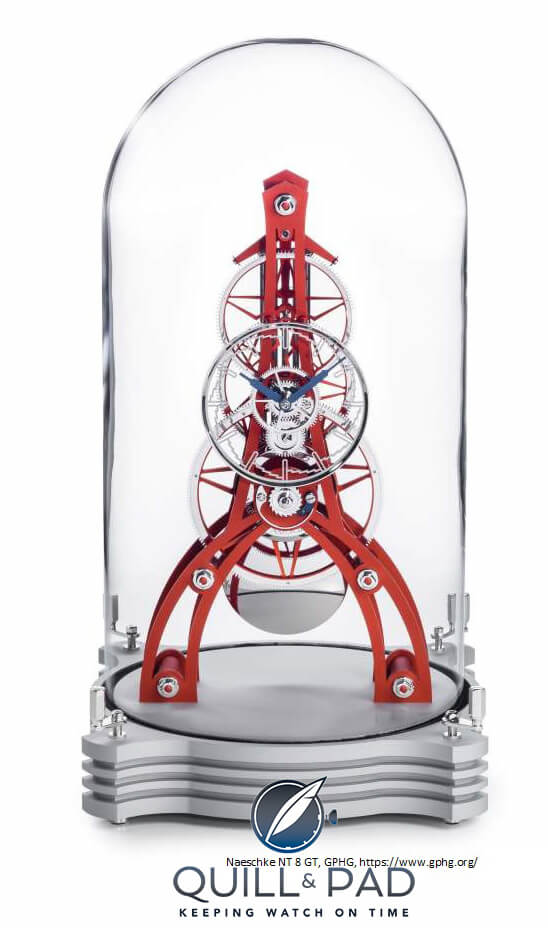
Naeschke NT 8 GT in red alloy
The classic NT 8 is a sublime table clock with a 7-day skeleton movement that is extremely slim and. It has a highly polished varnished nutwood case with metal inlays. The character of this clock is expressed by its cover – a traditional looking hand-blown glass dome made for this clock by traditional glasswork masters in Germany. The NT8 GT is an open-worked table clock inspired by lightweight aviation constructions. It has a 7-day power reserve with a very nice and unusual dial design that marks the seconds with five steps for every five seconds.
Naeschke NT 8 GT: price €22.500, more information at https://fine-clocks.com/clocks/clocks/table-clocks/table-clock-nt-8-gt
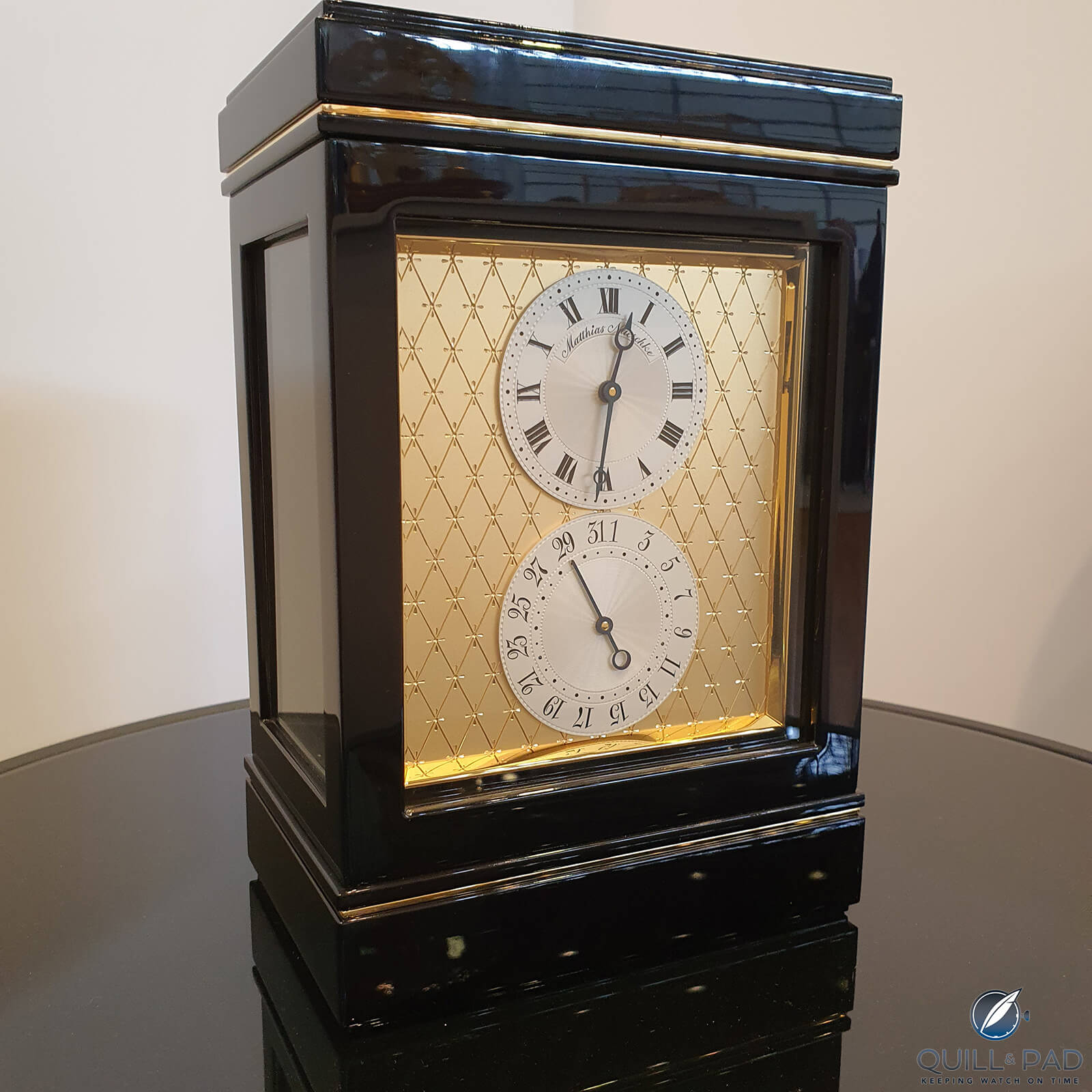
Naeschke NT 9 table clock (photo courtesy Thomas Brechtel)
The Naeschke NT 9 table clock is an elegant smaller size classical table clock with an engraved gilded dial featuring flowers on the crossing point of straight lines. It indicates the hours, the minutes, and the date on a smaller second dial.
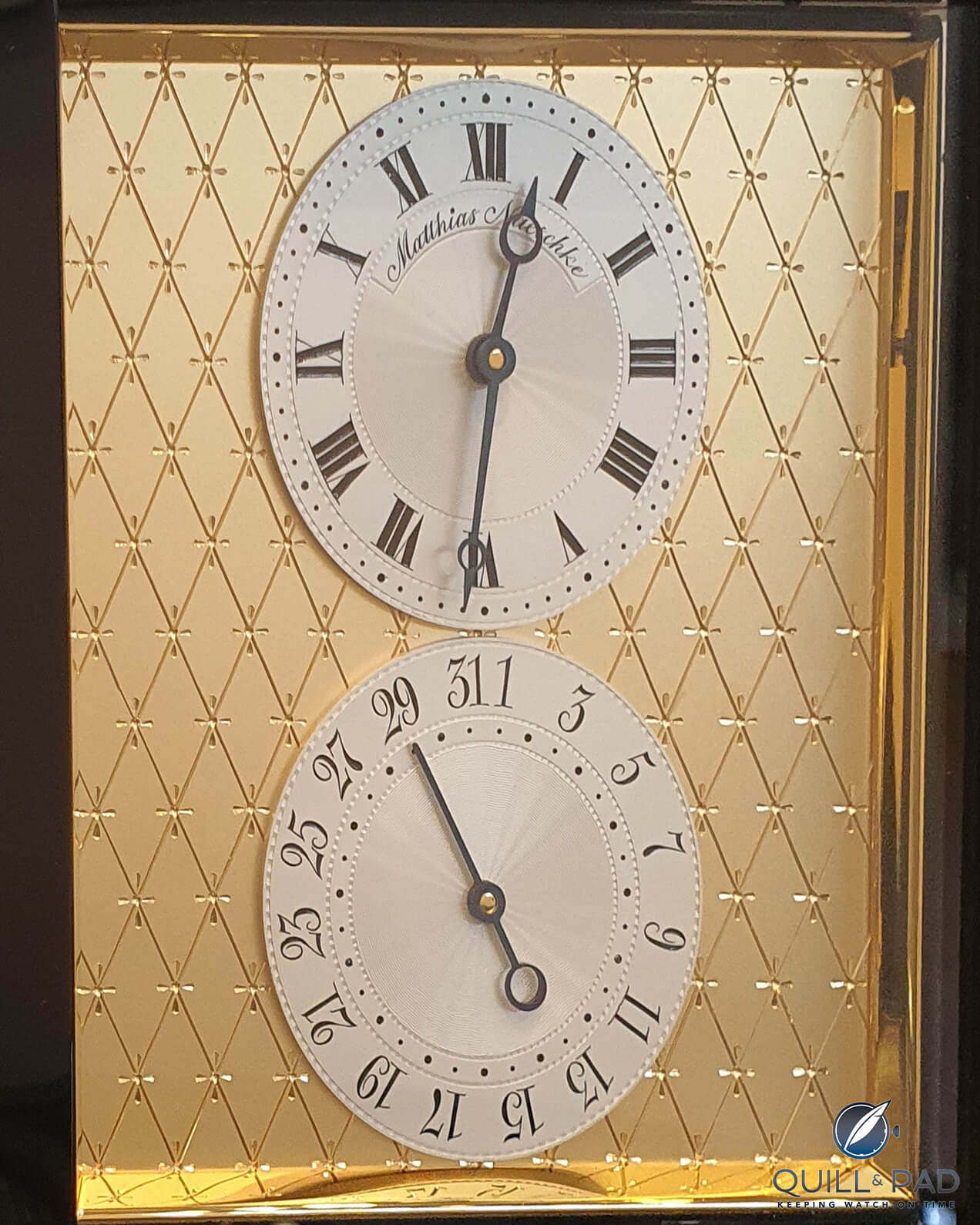
Naeschke NT 9 dial by Jochen Benzinger (photo courtesy Thomas Brechtel)
The dial is guilloched by the renowned German guillocher, Jochen Benzinger. The NT9 has a power reserve of 14 days and beats at 2 Hz (14.400 bph).
Naeschke NT 9: price €12,500, more information at https://fine-clocks.com/clocks/clocks/table-clocks/table-clock-nt-9
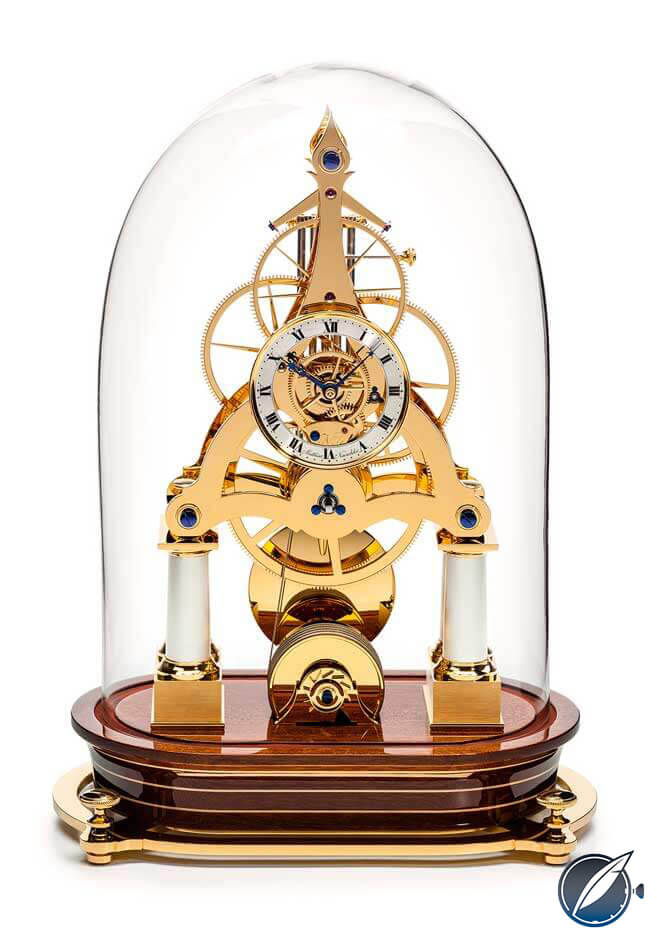
Naeschke NT 10 table clock
The skeleton table clock Naeschke NT 10 is a fine clock with a hand-blown glass dome and a 31-day power reserve. Its design takes inspiration from the construction of ships. The clockwork is mounted on four heavy, solid metal pillars.
Naeschke NT 10: price €31,300, more information at https://fine-clocks.com/clocks/clocks/table-clocks/table-clock-nt-10
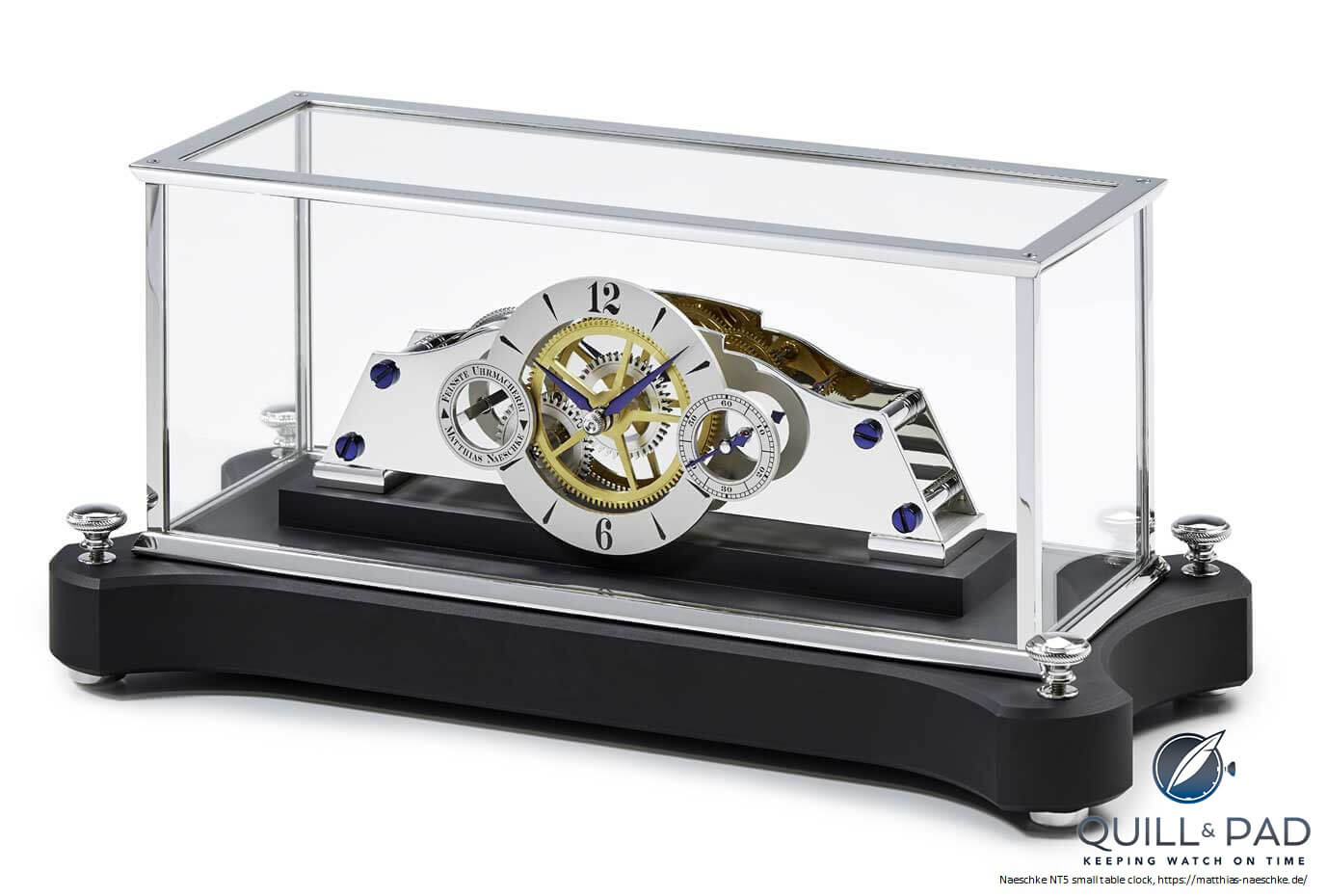
Naeschke NT 5
The smallest clock made by Naeschke is the NT 5. It is a small and beautiful table clock with the Naeschke caliber 5 movement featuring a 14-day power reserve beating at a sedate 2 Hz (14,400 bph).
Naeschke NT 5: price €8.850, more information at https://fine-clocks.com/clocks/clocks/table-clocks/table-clock-nt-5
“We miss her”
The downside: Naeschke’s clocks are relatively expensive (though not compared to fine wristwatches). The clocks are beautiful – and beauty comes at a cost – so unfortunately, do not own one (not yet anyway). But I dream of owning one because they are much more than just a clock, they are sheer beauty: priceless timekeepers.
A large clock is for eternity and is a comforting roommate. The old and large regulator clock in my parents’ house even has a name, ‘Grandma Suse’, and she lives together with them. Whenever I occasionally take it to a clockmaker for a service, they ask, “where is she, when will she be back, we miss her?”
For more information, please visit https://fine-clocks.com/home
You might also enjoy:
Alain Silberstein x Philippe Lebru KB2 Monochrome Clock: A Rare Silberstein Without Color
Fiona Krüger Vanitas: A Skull Clock That Yawns To Indicate Becoming Tired And Needing More Energy
Ulysse Nardin UFO Clock: Not Your Typical UFO Sighting, But It Quite Literally ROCKS!
Discovering The Secret Of Life With David Walter: Watches, Clocks, And DeeDee’s Tourbillon
Leave a Reply
Want to join the discussion?Feel free to contribute!



The kind of article that makes Q&P unique. Thank you (also for the “You might also enjoy”)
Dear Cuentatiempos, I was a little unsure at first, since we are talking about large clocks. They are always a bit out of the mainstream. I’m all the more pleased that you like this article. Thank you very much, Thomas
Much appreciated comment thank you.
Regards, Ian
Every time I read an article like this, it makes me want to build a clock kit, or find an old non-working clock and repair it.
Such art.
Dear Steve, wow. This is great to read. I am so happy about your admiration of large clocks. If I started building something like that, I would end up with a lump of metal or a radio.
Be well, regards, keep us informed about your clock, Thomas
What a joy it was to read this piece and see these works of mechanical art. I have three antique clocks in my living room, though nothing to compare with what was presented here. I wish that there were kits available so that we could enjoy the assembly and finishing of a clock – and I’m not referring to the cabinet kits with a ready-made movement. Nice addition to Quill & Pad. More please!
Hi Steve, thank you for this motivating feedback. I can understand your fascination. Unfortunately, I know of almost no one who offers fine and elaborated kits, but you may be able to find one at Erwin Sattler or Müller & Sattler. They offer some kits in the Mechanica series.
In addition, I can start with a list of large clocks and some makers (incomplete, alphabetical):
Animaro Design, Hermle, Humanssince1982, Keris Wall Clocks, Kieninger, Lepee, Miki Eleta Unique Timepieces, Moving Mechanics Time Machines (Florian Schlumpf), Meccaniche Orologi Milano MOM (Alessandro Rigotto), MyWayWatchConcept Pendulum Clocks, Matthias Naeschke, Sinclair Harding (Robert Bray), Thomas James Clocks, Utinam, … This is a wide range of very different large clocks. Best regards, Thomas
Wao! thanks again for that list.
with pleasure, Cuentatiempos. I’m glad. We all need more clocks : )
Look into a used Atmos. They are works of art and run on a unique principle, never needs winding.
thank you very much Seth, I can only agree, really great, especially the very early Reuter Atmos from the 1930s are worth paying attention to. Regards, Thomas
If you would like to know, where most of the cabinets are produced, You Can look at our webside and contacts are always welcome.
Best regards Wolfgang
Thanks you very much, danke vielmals Herr Wochner, for this additional information. Oh yes, if you are careful enough, dear readers, you can detect the cabinet of the mighty BCHH Celestial Infinity Table Clock on the Josef Wochner homepage (which is a German language homepage). You will find it here: https://josef-wochner.de/
Viele Grüße, Thomas
Great story